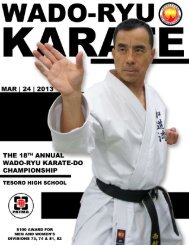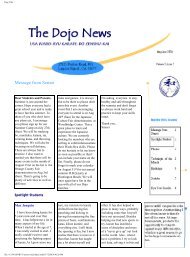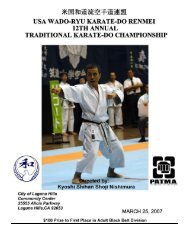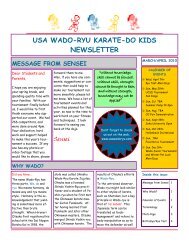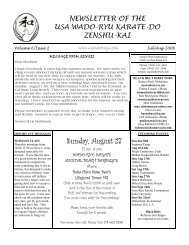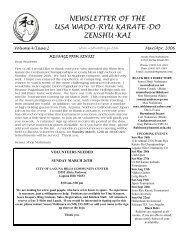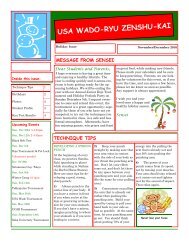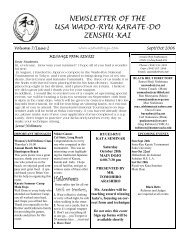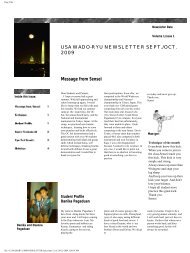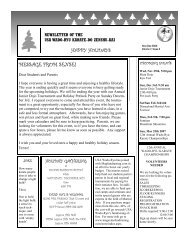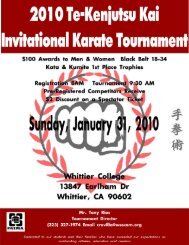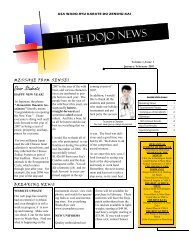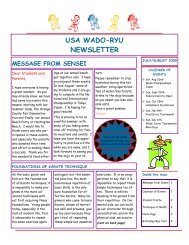SHOJI NISHIMURA Excellence in Action - USA Wado Ryu Karate-Do
SHOJI NISHIMURA Excellence in Action - USA Wado Ryu Karate-Do
SHOJI NISHIMURA Excellence in Action - USA Wado Ryu Karate-Do
You also want an ePaper? Increase the reach of your titles
YUMPU automatically turns print PDFs into web optimized ePapers that Google loves.
N ISHIMURA<strong>SHOJI</strong><strong>NISHIMURA</strong><strong>Excellence</strong> <strong>in</strong> <strong>Action</strong>By Jose M. FraguasOne of the first th<strong>in</strong>g that strikes aboutSensei Nishimura is his confidence.He knows what he can do and he is sure with<strong>in</strong>himself. When you look at his roots and experience <strong>in</strong>the art of <strong>Wado</strong> <strong>Ryu</strong> <strong>Karate</strong>, he just seems to have completelydef<strong>in</strong>ed an important era <strong>in</strong> the U.S. for the style developed by the greatHironori Ohtsuka. His approach to karate tra<strong>in</strong><strong>in</strong>g is rem<strong>in</strong>iscent of the attitudeof those who reached greatness: “In <strong>Karate</strong> you have to tra<strong>in</strong> hard and relentlessly,chase the perfection <strong>in</strong> technique, know<strong>in</strong>g full well that it doesn’t existand you will not reach it because noth<strong>in</strong>g is perfect. But you have to chase itbecause <strong>in</strong> the process you will reach excellence,” he says. “You can’t settleyourself with be<strong>in</strong>g just good.”How many styles have you tra<strong>in</strong>ed <strong>in</strong> and who were your teachers?I have been practic<strong>in</strong>g karate s<strong>in</strong>ce I was 14 years old. Also, I have been practic<strong>in</strong>g <strong>Ryu</strong>kyu kobudo,sai, nunchaku, and bo. In addition, I tra<strong>in</strong> <strong>in</strong> iaido, aiki-jujitsu. My first experience with Martial Artswas <strong>in</strong> the Saga prefecture of Karatsu, Japan. I was first <strong>in</strong>troduced to karate when my friend <strong>in</strong>vitedme to go see the new dojo that was built <strong>in</strong> the area. This dojo practiced full contact sparr<strong>in</strong>g, break<strong>in</strong>gstones, bricks, and makiwara punch<strong>in</strong>g. Watch<strong>in</strong>g the punches and kicks of the black belts fromthe ma<strong>in</strong> branch dojo lit up my eyes. I started attend<strong>in</strong>g three times a week and built a sandbag filledwith sand and stones to practice my punches and kicks.My first experience with karate was full-contact style karate. It did not really have a name to it, butthey practiced sparr<strong>in</strong>g with other clubs and even kick-boxers. A couple of years later, we started wear<strong>in</strong>gprotection similar to that worn by Nippon Kempo. However, it made almost no difference; everyth<strong>in</strong>gstill hurt really bad. I especially remember this one way of tra<strong>in</strong><strong>in</strong>g where you held your kamaestance while other hit you from all directions. The purpose of this exercise, if you can call it that, wasto improve your balance and strengthen the body. For kyu tests, we had to break stones. When I startedattend<strong>in</strong>g Risshyo University, I naturally jo<strong>in</strong>ed the karate club. This university had many styles ofkarate, <strong>in</strong>clud<strong>in</strong>g Goju-ryu, Shito-ryu, and <strong>Wado</strong>-ryu. I jo<strong>in</strong>ed the <strong>Wado</strong>-ryu club because it had themost members. All we did for the entire first year was practice kihon to remove any bad habits. Then,we slowly added kumite and shadow-tra<strong>in</strong><strong>in</strong>g. There was no kata practice until maybe two weeks beforethe kyu or dan test<strong>in</strong>g. At the time, kata was not a big priority.36 Fall 2010
Martial Arts Masters 37
N ISHIMURA<strong>Excellence</strong> <strong>in</strong> <strong>Action</strong>Would you tell us some <strong>in</strong>terest<strong>in</strong>g stories of yourearly days <strong>in</strong> karate?Suzuki Susumu was the head coach of the karateclub at the university. He was <strong>in</strong>credibly strict andalways made us do kihon for one hour and thenkumite afterwards. If kiais were weak, you wereslapped. Sensei Suzuki had very good kicks, usuallytarget<strong>in</strong>g his opponents’ sh<strong>in</strong>s. He also demonstratedmany open-handed techniques target<strong>in</strong>gthe face. Sensei Suzuki subsequently moved toBrazil where he cont<strong>in</strong>ued to teach karate.After Sensei Suzuki’s departure, SenseiSetamatsu from the Honbu dojo came to teach.This <strong>in</strong>structor taught us concepts of parry, deflection,and efficient body movement. He was especiallyskilled <strong>in</strong> kumite, generally keep<strong>in</strong>g very littledistance from his opponent as if to lock theopponent from us<strong>in</strong>g their techniques. Dur<strong>in</strong>gcollege, it seemed all we did was practice, andquantity over quality was our motto. SuzukiSensei always told us to get <strong>in</strong>volved <strong>in</strong> streetfights to strengthen ourselves mentally and physically.I tried it once but I was too excited and mypunches and kicks were <strong>in</strong>accurate and I remembertripp<strong>in</strong>g and fall<strong>in</strong>g.When I first started karate, our sensei wouldtake us to other dojos to learn other styles’ techniquesand skills – kumite, especially, with manydifferent fight<strong>in</strong>g styles. I was able to experiencean array of different skills. It was very <strong>in</strong>spir<strong>in</strong>gand motivat<strong>in</strong>g. I remember specifically the <strong>Ryu</strong>kyustyle; they hit everywhere: the sh<strong>in</strong>s, knees,ribs, with their toes. Today, we rarely make contactwith other dojos, and we would not eventh<strong>in</strong>k to practice with Kung Fu or Tae Kwon <strong>Do</strong>people. <strong>Do</strong>jos today are full of kids and what theyteach is mostly the same: how to score po<strong>in</strong>ts <strong>in</strong>kumite and mak<strong>in</strong>g a kata look good <strong>in</strong> tournaments.There doesn’t seem to be any diversityanymore.How has your personal expression karate developedover the years, and what is it that keepsyou motivated after all these years?When I first started karate, the emphasis was onbrute strength and be<strong>in</strong>g able to w<strong>in</strong> fights. Butnowadays, as people – <strong>in</strong>clud<strong>in</strong>g myself – getolder, such ways of tra<strong>in</strong><strong>in</strong>g are detrimental to thebody. What I utilize and teach now is based on rigitankyu.Rigitankyu is a doctr<strong>in</strong>e whereby onepursues the ultimate goal <strong>in</strong> life while search<strong>in</strong>gfor skills of effortless movement and freedom ofbody motion, which abide by Natural Law. Afterlong years of tra<strong>in</strong><strong>in</strong>g, research<strong>in</strong>g and experiment<strong>in</strong>g<strong>in</strong> Martial Arts, I feel that there is noone ultimate technique. There is no guaranteethat a kumite champion will rema<strong>in</strong> the championyear after year. Techniques are <strong>in</strong>f<strong>in</strong>ite, likethe stars <strong>in</strong> the universe. Bugi (Martial Arts techniques)has no one perfect technique that canovercome any other. Techniques are not immuneto change and must be able to adapt accord<strong>in</strong>g toeach situation. A block can defend aga<strong>in</strong>st a certa<strong>in</strong>punch but may be <strong>in</strong>effective when thepunch is thrown from a different angle. Oneshould not limit him/herself to learn<strong>in</strong>g just a particularpunch or block but hav<strong>in</strong>g your body movereflexively to each situation, and is what I th<strong>in</strong>kto be the true mean<strong>in</strong>g and essence of <strong>Wado</strong>-ryu.Martial Arts is not all about fight<strong>in</strong>g; its foundationis shizen no ugoki, the natural movement ofthe body. Rather than oppos<strong>in</strong>g or resist<strong>in</strong>g an38 Fall 2010



